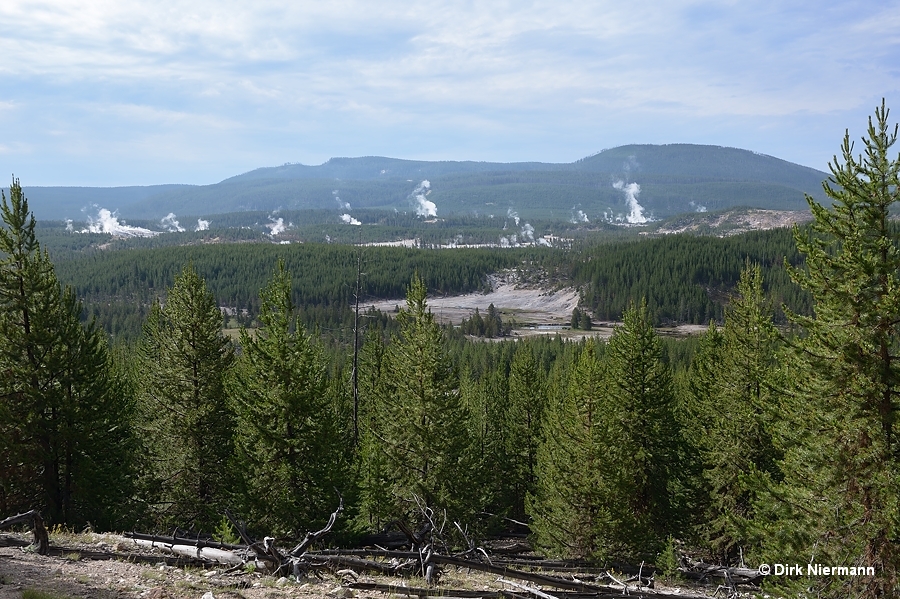Norris Geyser Basin of Yellowstone
Norris Basin, named in honor of Philetus Walter Norris, the park's second superintendent, lies about 4 km ( 2.5 miles) north of the northwest rim of the 640,000-year-old Yellowstone caldera and is the northernmost geyser basin in the park. Scientists believe that more or less continuous thermal activity at Norris dates back more than 150,000 years before present, making it the earliest hydrothermal basin of Yellowstone. Norris is also regarded as hottest geyser basin and as such it comprises a huge number of impressive geysers, including the currently tallest geyser all around the world, Steamboat Geyser. Besides a variety of acidic, neutral, or alkaline geysers, it features as many different types of hot spings, mud pots, and fumaroles as no other area in the park. Norris Porcelain Basin and Norris Back Basin are easily accessible and served by a large parking lot, while the other thermal areas within the region, Sulfur Dust Area, One Hundred Spring Plain, Upper and Lower Tantalus Basin, and The Gap are either closed to public entry or should be visited only by very experienced parties.
One Hundred Spring Plain is home of the bizarre Cinder Pool, whose milky water is half covered by black, nearly pea-sized cinders of elemental sulfur and dispersed iron(II) sulfide, while a submersed lake of molten sulfur rests on its 18 m (59 feet) deep bottom. Cinder Pool's extreme chemistry and high temperature of 88 °C (190 °F) provide living conditions almost exclusively to hyperthermophilic bacteria of the genus Hydrogenobaculum. The plain also hosts Beowulf Spring, where researchers led by William P. Inskeep in 2010 discovered the thermoacidophilic archaeon Metallosphaera yellowstonensis from iron(II)-rich orange microbial mats. This microbe, thriving at temperatures up to 72 °C (162 °F), uses iron(II), elemental sulfur, or pyrite as energy source.
The following picture shows Norris Geyser Basin as seen from a northern roadway turnout. The large steam plume on the very lefthand side belongs to Porcelain Basin. The steam plume in center marks the position of Steamboat Geyser in Back Basin. Just in front of it the bare area of One Hundred Spring Plain can be spotted, which is not accessible by Norris Basin walkways. On the right side another large steam plume is visible, emitted by the Gray Lakes in the south corner of Norris Back Basin.

While nowadays the highway is running east of Norris Geyser Basin, the old road, built on the initiative of P.W. Norris in 1878 and removed in 1966 in favor of the Norris Junction bypass, cut right through the basin's center. In the north it entered Porcelain Basin between Nuphar Lake and the Porcelain Springs, passed just northwest of Congress Pool and continued on the present hiking trail via Norris Museum (which was built in 1929) and Bathtub Spring to meet a stagecoach stop west of Minute Geyser. From there it proceeded through the woods and northwest of Recess Spring and Big Blue Spring to join the present highway southwest of Norris Basin on the open meadows of Elk Park, close to a loop of Gibbon River.
Special to Norris Geyser Basin is a temporary increase in the water supply of hot springs, affecting their activity, temperature, turbidity, or acidity. Occurring not in every year and lasting at most a few days, this activated state, called disturbance, is most commonly observed in late summer. Therefore, it is sometimes referred to as "seasonal disturbance" but also "annual disturbance". Besides basin-wide disturbances also ones focused on sections of Norris Basin are known. There are several geysers at Norris, which are almost exclusively playing during a disturbance, and even quiet hot springs, not known as spouters before, may briefly turn into geysers, too. Scientists do have no final explanation of the mechanisms, but they believe that a decrease of the ground water level during the summer may depressurize the subjacent hydrothermal system and support a rise or convection of superheated water and steam. However, there must be additional factors involved such as tectonic events because a disturbance can also occur in spring or at other times of the year.
If you are lucky to visit Norris Geyser Basin once during an ordinary period and on another occasion during a disturbance, you will experience very different hydrothermal events. On top of that, also the effects of disturbances may come in notable variations.